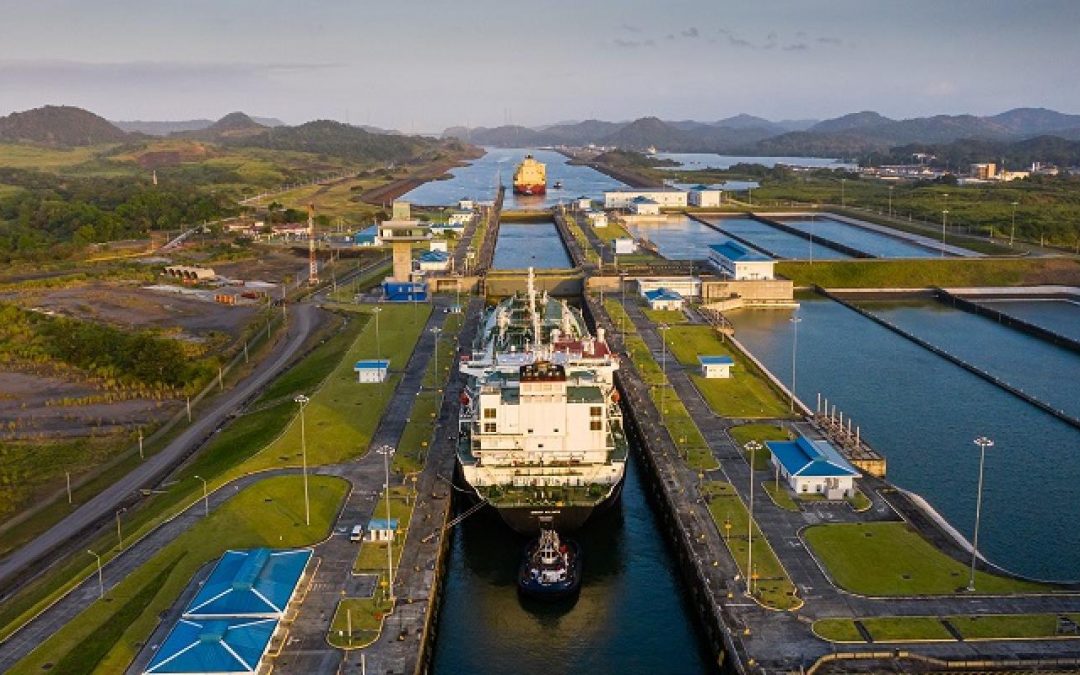The Panama Canal, one of the largest waterways in the world, is the main artery of global trade. Located on the border between North and South America and connecting the Atlantic Ocean with the Pacific, the canal helps shipping companies transport grains, food supplies, and consumer goods to other parts of the world. However, the canal is currently seeing its lowest water levels in history. The extreme drought in the region of the Panama Canal has serious social, economic, and political implications as it stifles exports of grains and other consumer goods.
According to data from the Smithsonian Tropical Research Institute, the Panama Canal is currently experiencing extreme drought and it is seeing its lowest water levels in history. This leads to repercussions on the transportation and shipping of consumer goods and food supplies across the world.
Experts blame the extreme drought on the El Niño weather pattern. El Niño is a climate phenomenon that causes the Pacific jet stream to move south and spread further east during the winter season, supplying South American regions with heavy rainfall. However, the summer season is also being prolonged. As a result, southern parts of the US, along with Panama and other neighbouring regions, are currently experiencing exceptional drought conditions.
Temperature changes in the region have also caused the water of the Panama Canal to dry up. Temperatures here were slightly above the average in recent weeks, ranging between 85-90F (29-32C).
How Is the Panama Canal Important for World Trade?
The ships travelling through the Panama Canal efficiently transports grains, food supplies and consumer goods to all parts of the world. Serving as a maritime shortcut, its effectiveness lies in its strategic geographic location, which allows ships to transit through the canal instead of navigating all the way to the southern tip of South America.
This crucial artery has several main routes to ensure that consumer goods are being exported to all corners of the world. The US East Coast is connected to Asia as well as the West Coast of South and Central America. Europe and the West coast of Central America are also connected through the canal. The canal also shortens the maritime distance between the North American East and West coasts by 13,000 kilometres (8,078 miles). Its efficient geographical location makes it one of the most frequently used waterways in the world.
The Panama Canal has the ability to save time and distance as it can reduce the sailing distance from the Atlantic to Pacific and vice versa by a vast 8,000 nautical miles. The route of the canal also reduces ship travel time from the Atlantic to the Pacific by about 5 months, its efficiency and time-saving nature make it a crucial resource for the shipping industry, with an estimated 6% of global trade passing through it.
In the fiscal year 2022, the canal registered a total of 14,239 transits, transporting 291 million tons of goods, and paying tolls that totalled US$3,028 million. According to the International Trade Administration, in 2021, the last year for which data is available, revenue from canal tolls amounted to nearly US$3 billion.
Japan, China, and the US are the three largest users of the waterway, with the latter being the leading country out of the three. In the fiscal year 2021, the United States was the origin or destination of 72.5% of all ships crossing the canal. China came in second, with 22.1% of the traffic being ships from China. Japan followed closely with 14.7%.
How is the Panama Canal Drought Affecting Global Trade?
As of mid August, the Panama Canal Authority is restricting the number of vessels authorised to pass per day to a maximum of 32. In early September, the number of ships waiting to cross the Canal had risen to 127. These restrictions leave the shipping industry unable to experience the timesaving benefits of the renowned waterway.
As holidays such as Halloween, Thanksgiving, and Christmas are quickly approaching, late August is usually the peak season of online orders. Consumers around the world are rushing to online retailers, looking to order presents, decorations, costumes and other consumer goods in preparation for the festive season. The restrictions put in place in the canal, which are expected to be in place for at least ten months, inevitably put a strain on the amount of goods being exported. The supply shortage caused by shipping delays also leads to a rise in goods’ prices.
Antonio Dominguez, managing director of Maersk, a worldwide shipping company and the largest single user of the canal, worries that delays caused by the drought could result in an increase of consumer goods’ prices.
Aside from evaluating impacts of the Panama drought from a consumer perspective, the cost of shipping – for shipping companies to even have access to the canal – is also expected to rise significantly. According to Intermodal Research Analyst Chara Georgousi, the drought-related disruptions at the canal have led to increased shipping costs, mainly affecting companies that frequently pass through it. The same concern is being expressed by Dominguez, who also worries about the high costs his company will likely face in the coming months.
The Canal Isn’t the Only Waterbody Experiencing Severe Drought Conditions
This is not the first time that climate change has impacted global trade. European countries have faced similar challenges last year, with essential canals drying up, disturbing the global trade and affecting economies worldwide.
This time last year, the River Rhine became impassable due to record high temperatures brought about by climate change, sparking concerns to European trade. Similar to the Panama Canal, the Rhine is also Europe’s most important waterway and Germany’s main economic artery as grain exports, coal, and other consumer goods rely on the functionality of the river for global trade.
Similarly, Italy’s longest river, river Po, faced extreme drought in May of 2022, due to record-breaking high temperatures and long-lasting absence of precipitation in the region. This had severe consequences on Italy’s economy, as the region surrounding the river is also the main industrial and agricultural area of the country, and is home to nearly one-third of Italy’s total population.
Conclusion
The Panama Canal drought proves that climate change has the ability to impact all aspects of life – not only placing severe impacts on biodiversity and human health but also hindering the global economy. With restrictions expected to last until 2024, authorities have now begun to evaluate the efficiency of water regulations in the canal.
Source: Hellenic Shipping News





